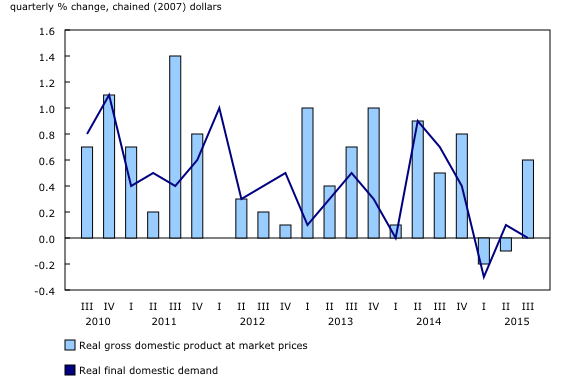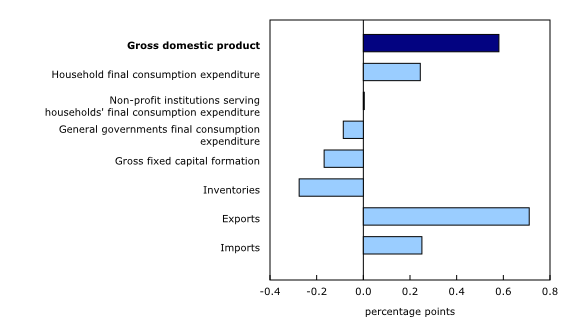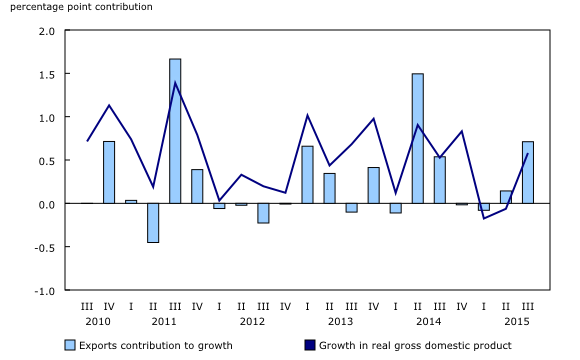Gross domestic product, income and expenditure, third quarter 2015
Archived Content
Information identified as archived is provided for reference, research or recordkeeping purposes. It is not subject to the Government of Canada Web Standards and has not been altered or updated since it was archived. Please "contact us" to request a format other than those available.
Released: 2015-12-01
Real gross domestic product (GDP) rose 0.6% in the third quarter, following two consecutive quarterly declines. The quarterly growth was driven by increased international demand for Canadian goods and services as exports grew 2.3%.
Final domestic demand was flat after edging up 0.1% in the previous quarter. Household final consumption expenditure rose 0.4%, and residential investment increased 0.6% after a flat second quarter.
Exports of goods advanced 2.7% after increasing 0.5% in the second quarter. Exports of services edged up 0.1%. Imports of goods and services decreased 0.7%, in tandem with weak domestic demand.
Household final consumption expenditure on goods rose 0.8% in the third quarter, driven by outlays on durable goods (+2.3%). Expenditure on services edged up 0.1%.
Final consumption expenditure of the general governments sector decreased 0.4% in the third quarter, following a 0.4% increase in the second quarter. Declines occurred at all levels of government.
Business gross fixed capital formation fell 0.8%, the third consecutive quarterly decline. Investment in non-residential structures and machinery and equipment declined 1.5%.
Businesses reduced their inventory accumulation to $0.6 billion in the third quarter after adding $5.3 billion in the second quarter. Businesses added $3.9 billion to non-farm inventories, compared with $9.2 billion in the previous quarter. Farm inventories were drawn down by $2.1 billion, the seventh consecutive quarterly decrease, as grain holdings were sold off.
Expressed at an annualized rate, real GDP expanded 2.3% in the third quarter. By comparison, real GDP in the United States rose 2.1%.
Exports drive growth
Exports of goods and services increased 2.3%, following a 0.5% gain in the second quarter.
Exports of goods rose 2.7%, following a 0.5% increase in the second quarter. Exports of motor vehicles and parts grew 5.0%, led by passenger cars and light trucks (+6.0%). Exports of consumer goods (+8.7%) and crude oil and crude bitumen (+5.7%) also contributed to the overall gain. Declines were recorded in metal and non-metallic mineral products (-1.8%) and basic and industrial chemical, plastic and rubber products (-2.4%).
Exports of services edged up 0.1%, following a 0.4% gain in the second quarter. Exports of commercial (+0.3%) and transportation (+0.3%) services contributed to the increase. These gains were mitigated by declines in travel services (-0.4%) and general governments services (-2.7%).
Imports decline
Imports of goods and services fell 0.7% in the third quarter, following a 0.5% decline in the previous quarter.
Imports of goods were down 0.7%, following a 0.5% decline in the second quarter. Lower imports of passenger cars and light trucks (-7.8%), food, beverage and tobacco products (-7.0%) and intermediate metal products (-7.4%) were the main contributors to the decrease. These declines were offset by gains in imports of tires, motor vehicle engines and parts (+6.2%), communications and audio and video equipment (+11.9%) and basic chemicals and industrial chemical products (+8.3%).
Imports of services fell 1.0%, the largest decline since the second quarter of 2013. The decrease was driven by lower imports of travel services (-1.7%), transportation services (-1.1%) and commercial services (-0.5%). Imports of services by the general governments sector increased 0.4%.
Household spending increases
Household final consumption expenditure increased 0.4% in the third quarter, following a 0.6% gain in the second quarter. Outlays on goods were up 0.8%, driven by durable goods (+2.3%). Semi-durable (+0.2%) and non-durable (+0.2%) goods also contributed to the increase. Outlays on services edged up 0.1%.
Expenditures on transport rose 2.2%, driven by purchases of vehicles (+3.5%) and operation of transport equipment (+1.2%). Recreation and culture (+1.1%) and food and beverage services (+0.4%) also contributed to the growth in household spending. Expenditures on clothing and footwear (-0.3%) were lower.
Investment in housing picks up
Business investment in residential structures grew 0.6% following a flat second quarter. The growth was driven by new construction (+3.2%), which offset declines in renovations (-1.6%) and ownership transfer costs (-0.7%).
Business investment in non-residential structures down again
Investment in non-residential structures decreased 1.7%, the fourth consecutive quarterly decline and the seventh in eight quarters. Engineering structures (-1.8%) and non-residential buildings (-1.0%) both decreased.
Investment in machinery and equipment fell 1.1%, a third consecutive quarterly decline. The decrease was led by industrial machinery and equipment (-3.3%). On the other hand, investment in communications and audio and video equipment grew 3.2%.
Investment in intellectual property products fell 2.1%, a third straight quarter of decline. Mineral exploration and evaluation (-9.3%) and software (-2.0%) were responsible for the decline. Investment in research and development increased 1.3%.
Business inventory accumulation slows
Businesses reduced non-farm inventory accumulation to $3.9 billion in the third quarter, down from $9.2 billion in the second quarter.
Manufacturing inventories were up by $1.8 billion, mainly in non-durable goods (+$1.5 billion). Retail inventories increased by $0.9 billion, also mainly in non-durable goods (+$0.8 billion). Motor vehicle inventories fell by $0.4 billion, as vehicles were liquidated following a $2.6 billion accumulation in the second quarter. Wholesalers drew down $2.6 billion of inventory after three quarters of accumulation. Farm inventories were down by $2.1 billion, a seventh consecutive quarterly decline.
The stock-to-sales ratio edged down to 0.760 in the third quarter. This was the second highest stock-to-sales ratio since the second quarter of 2009.
Terms of trade weaken
The terms of trade fell for the fourth quarter in a row, as rising import prices outpaced increasing export prices. The Canadian dollar depreciated against its American counterpart in the third quarter. Real gross domestic income edged down 0.1%.
Export prices increased 0.9% while import prices rose 2.9%. The overall price level of goods and services produced in Canada edged up 0.1%, after increasing 0.4% in the second quarter.
The price of final domestic demand was up 0.8%, the largest gain since the second quarter of 2011.
Modest growth in compensation of employees
Compensation of employees rose 0.2% in the third quarter following a 0.3% gain in the second quarter. Wages and salaries (+0.2%) and employers' social contributions (+0.3%) both increased. Wages and salaries in goods-producing industries declined by 1.2%, while wages and salaries in service-producing industries rose 0.7%.
The gross operating surplus of corporations increased 0.6% in the third quarter, following three straight quarterly declines. The gross operating surplus of non-financial corporations rose 0.4%, after three consecutive quarters of decline. The growth in the gross operating surplus of financial corporations (+0.5%) slowed considerably from the 4.8% growth recorded in the second quarter.
Overall, nominal GDP rose 0.7% in the third quarter, following a 0.4% increase in the second quarter.
Household saving rate decreases
The household saving rate decreased from 4.9% in the second quarter to 4.2% in the third quarter, as growth in household expenditure outpaced the growth in disposable income. The household debt service ratio, defined as household mortgage and non-mortgage payments divided by disposable income, was 14.09%, up slightly from 14.08% in the second quarter.
The national saving rate moved down to 2.9% in the third quarter, as national net saving fell 11.1% from the previous quarter. National disposable income was up 0.5%, after a 0.6% increase in the second quarter.
Note to readers
For information on seasonal adjustment, see Seasonally adjusted data – Frequently asked questions.
Percentage changes for expenditure-based statistics (such as personal expenditures, investment, exports, and imports) are calculated from volume measures that are adjusted for price variations. Percentage changes for income-based and flow-of-funds statistics (such as labour income, corporate profits, mortgage borrowing and total funds raised) are calculated from nominal values; that is, they are not adjusted for price variations.
There are two ways of expressing growth rates for gross domestic product (GDP) and other time series found in this release.
- Unless otherwise stated, the growth rates in this release represent the percentage change in the series from one quarter to the next, such as from the second quarter of 2015 to the third quarter of 2015.
- Quarterly growth can be expressed at an annual rate by using a compound growth formula, similar to the way in which a monthly interest rate can be expressed at an annual rate. Expressing growth at an annual rate facilitates comparisons with official GDP statistics from the United States. Both the quarterly growth rate and the annualized quarterly growth rate should be interpreted as an indication of the latest trend in GDP.
Revisions
Data on GDP for the third quarter have been released along with revised data for the first quarter 1981 to the second quarter of 2015. These data incorporate new and revised data and updated data on seasonal trends.
As well as incorporating new and revised source data and updated data on seasonal patterns, this release reflects revised estimates in accordance with the 2015 comprehensive revision of the Canadian System of Macroeconomic Accounts. Additional information is available in the article "Results from the 2015 Comprehensive Revision to the Canadian System of Macroeconomic Accounts."
As a component of the 2015 comprehensive revision of the Canadian System of Macroeconomic Accounts, the quarterly estimate of consumption of fixed capital is now based on the new quarterly stock and consumption of fixed capital program. This program incorporates quarterly estimates of geometric net stock and depreciation of non-residential (buildings, engineering, machinery and equipment, and intellectual property products) and residential assets in the new CANSIM table 031-0009.
Real-time CANSIM tables
Real-time CANSIM tables 380-8063 and 380-8064 will be updated on December 8. For more information, consult Real-time CANSIM tables.
Next release
Data on gross domestic product by income and by expenditure for the fourth quarter of 2015 will be released on March 1, 2016.
Products
The System of macroeconomic accounts module, accessible from the Browse by key resource module of our website, features an up-to-date portrait of national and provincial economies and their structure.
The document "Results from the 2015 Comprehensive Revision to the Canadian System of Macroeconomic Accounts," which is part of Latest Developments in the Canadian Economic Accounts (13-605-X), is now available from the Browse by key resource module of our website under Publications.
Contact information
For more information, or to enquire about the concepts, methods or data quality of this release, contact us (toll-free 1-800-263-1136; 514-283-8300; STATCAN.infostats-infostats.STATCAN@canada.ca) or Media Relations (613-951-4636; STATCAN.mediahotline-ligneinfomedias.STATCAN@canada.ca).
- Date modified:





